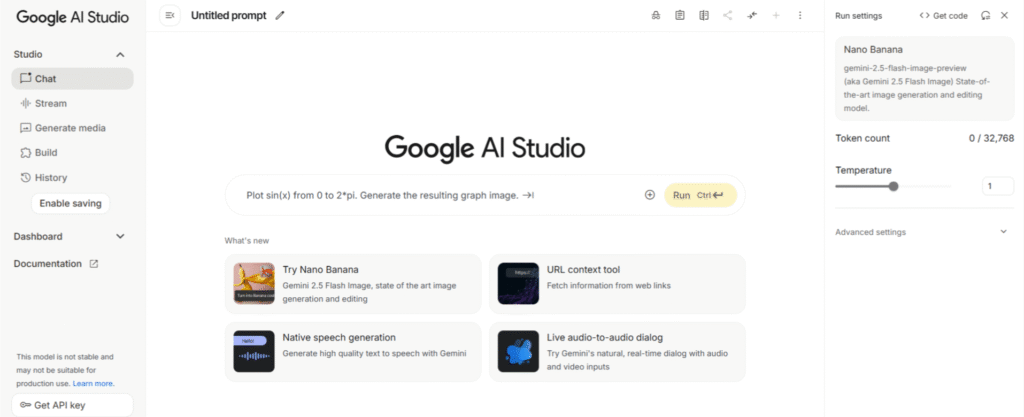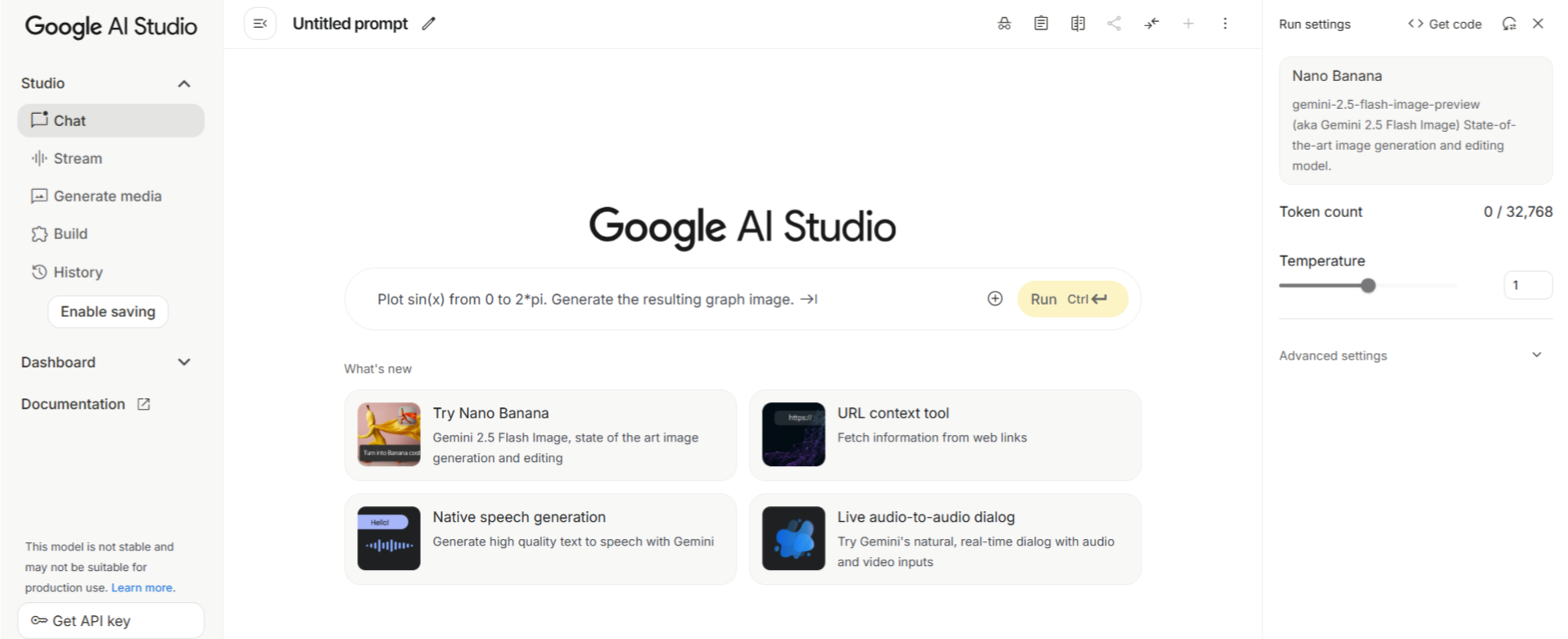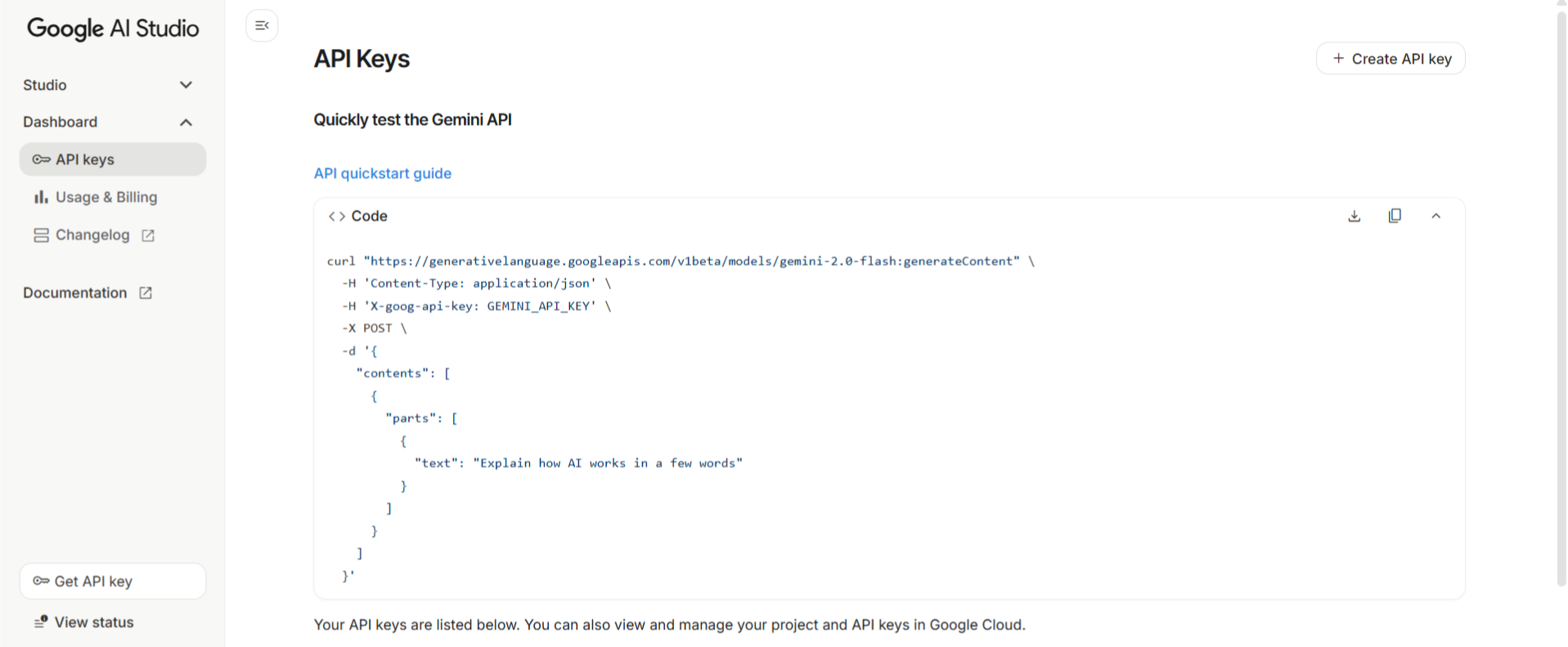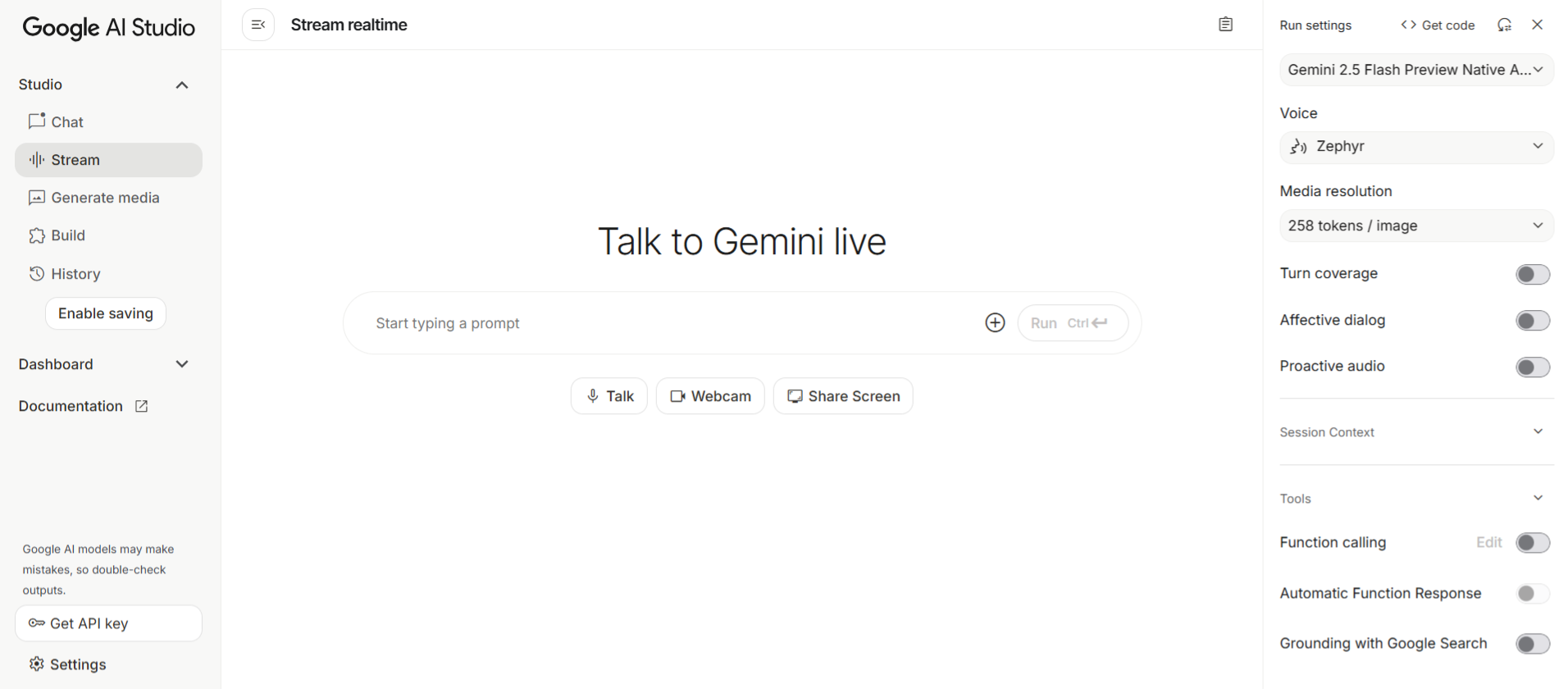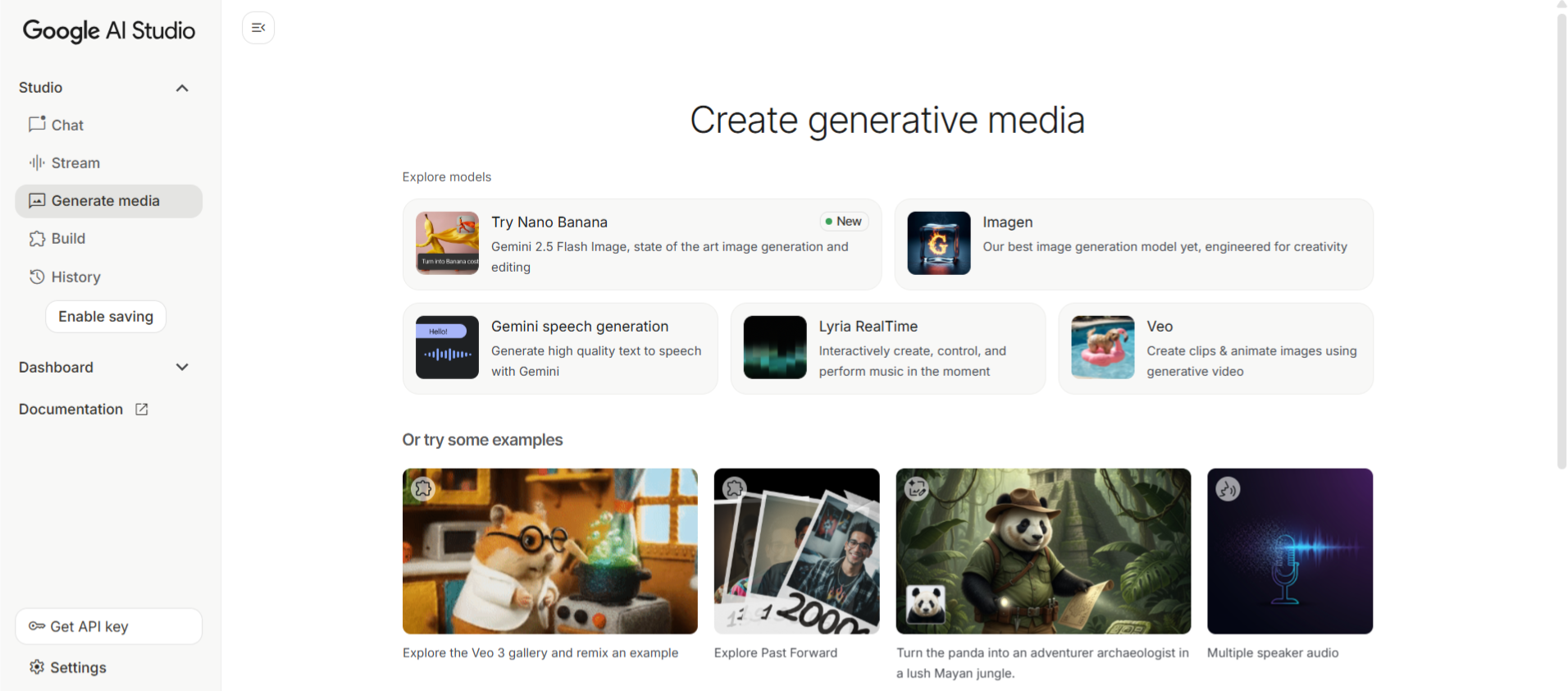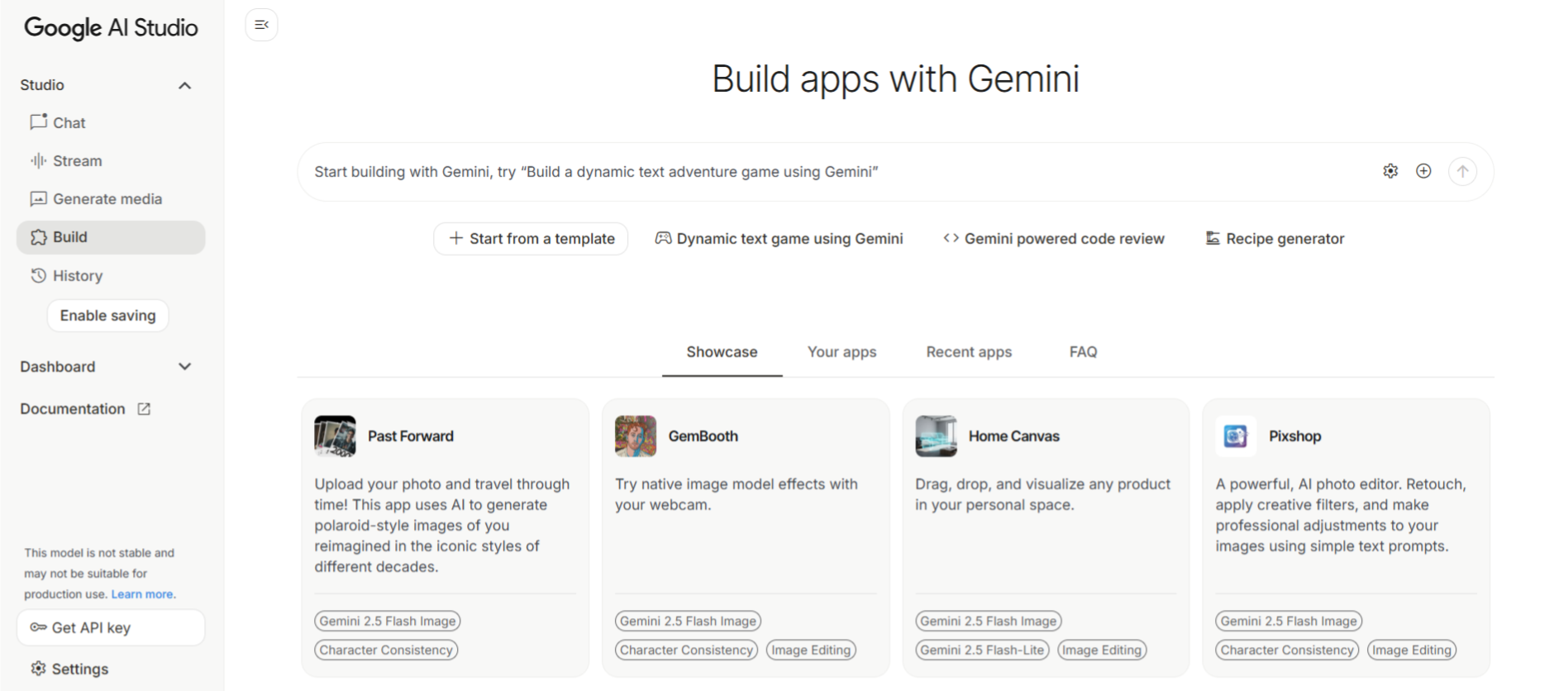Google AI Studio is a browser-based playground designed to make experimenting with Google’s powerful Gemini models simple and accessible. Instead of setting up complex development environments, users can log in, test prompts, refine outputs, and quickly export working code via the Gemini API. This ease of use allows anyone from beginners to seasoned developers to move from an idea to a working prototype in just minutes.
The platform is especially useful for makers, developers, and product managers. Makers can test creative ideas such as AI-powered chatbots or image generators without worrying about backend infrastructure. Developers benefit from the direct “Get code” feature that turns prototypes into usable snippets for Python or JavaScript. Product managers, on the other hand, can validate AI-driven features before handing them over to engineering teams, cutting down project timelines significantly.
What sets Google AI Studio apart from the consumer-facing Gemini app is its focus on building and deploying rather than casual use. While the Gemini app is tailored for everyday productivity—like drafting emails or brainstorming—Google AI Studio is geared toward prototyping applications, integrating APIs, and experimenting with multimodal capabilities.
At a glance, Google AI Studio supports a wide range of cutting-edge features:
- Text-based models such as Gemini 2.5 Pro and Flash for reasoning and efficiency.
- Multimodal support, enabling the use of images, audio, and even video as inputs.
- Realtime streaming, which makes conversations and interactions more natural.
- Imagen 4 integration, allowing users to generate high-quality images directly within the playground.
In short, Google AI Studio brings together flexibility, advanced AI capabilities, and code-ready outputs, making it a practical bridge between chat experiments and fully built applications.
Also Read: Google Rolls Out Verified Badge for Local Services Ads
Why Use Google AI Studio in 2025? (Benefits)
In today’s fast-paced AI landscape, speed and flexibility matter more than ever. Google AI Studio stands out in 2025 because it helps you move from an idea to a working prototype in record time. With the built-in “Get code” feature, you can test a prompt, validate the output, and instantly generate ready-to-use code in Python or JavaScript. For developers, this means less time setting up environments and more time building real applications.
Another big advantage is the ability to run multimodal experiments. Unlike traditional text-only tools, Google AI Studio lets you explore text, images, and even video inputs within the same workspace. For example, a product team could create a chatbot that analyzes support tickets, generates troubleshooting guides, and even reviews screenshots or video snippets uploaded by users. This kind of flexibility makes it easier to build solutions that mirror real-world use cases.
The platform also provides a prompt gallery filled with examples and templates. For newcomers, this serves as a learning library, while for experienced users it’s a source of quick inspiration. Whether you’re prototyping a customer service bot, drafting marketing copy, or experimenting with image generation through Imagen 4, the gallery shortens the learning curve.
That said, it’s important to know when to use Google AI Studio vs Vertex AI. AI Studio is ideal for individual creators, small teams, and early-stage prototypes where speed and experimentation are the priority. On the other hand, Vertex AI is designed for enterprise-grade needs, offering governance, large-scale deployment, model monitoring, and MLOps integrations. A startup might begin in Google AI Studio to validate an idea quickly, and later transition to Vertex AI once the solution needs to scale to thousands of users with compliance and monitoring baked in.
By blending speed, multimodal capability, and a clear path to production, Google AI Studio gives teams in 2025 a powerful way to go from concept to reality—without the usual roadblocks.
Google AI Studio Features You’ll Use Daily
When working with Google AI Studio, the real value comes from the everyday features that make prototyping and development both seamless and practical. These tools are designed to save time, reduce complexity, and give you more control over how AI integrates into your workflow.
- Chat prompts and multi-turn context
You can start with a simple prompt and continue building on it across multiple turns. This helps simulate real conversations, making it easier to prototype chatbots or virtual assistants that need memory and context. For instance, a customer support bot can remember earlier questions and provide relevant follow-ups instead of starting from scratch each time. - Realtime streaming and function calling hooks
With realtime streaming, responses don’t just appear all at once—they flow token by token, giving users a more natural, conversational feel. Pair this with function calling, and your app can trigger real-world actions, like checking inventory or booking tickets, based on AI responses. - Code export in JavaScript, Python, and more
After testing prompts, you can instantly generate code snippets for integration into your projects. This “Get code” feature removes the usual trial-and-error of wiring APIs manually. A developer can, for example, export Python code to plug directly into a Flask app or JavaScript for a Next.js frontend. - Prompt gallery and templates
Not sure where to start? The prompt gallery is filled with ready-to-use examples and templates. From marketing copy generators to JSON output validators, these templates shorten experimentation time and help users learn best practices quickly. - Model picker: Gemini 2.5 Pro/Flash, Imagen 4 family
Depending on your needs, you can select from high-performing models like Gemini 2.5 Pro for advanced reasoning, Gemini 2.5 Flash for faster, lighter tasks, or Imagen 4 for high-quality image generation. This flexibility means you’re never locked into a one-size-fits-all solution. - Safety settings, system instructions, and JSON mode
To ensure reliable and safe outputs, Google AI Studio lets you configure system instructions, adjust safety levels, and even enforce strict JSON mode for structured responses. This is critical for developers who need predictable, machine-readable outputs for downstream applications. - Rate limits and project keys
Like any API-driven tool, Google AI Studio provides project keys and enforces rate limits. This ensures fair usage and helps teams manage workloads efficiently. For example, a startup can track how many requests their prototype is making per day and scale usage before moving to production.
Together, these features make Google AI Studio not just a testing ground but a practical environment for building and validating real-world AI solutions every day.
From Chat to App in Minutes (Quickstart)
One of the biggest advantages of Google AI Studio is how quickly you can go from brainstorming an idea to having a functional prototype. The workflow is designed to be intuitive, giving developers, makers, and product managers a clear path from concept to code. Here’s how the process typically looks:
Step 1: Create a chat prompt in Google AI Studio
Start by setting up your prompt in the AI Studio interface. You can define system instructions to guide the AI’s behavior (e.g., “Answer like a friendly travel assistant”), set parameters such as temperature for creativity, and even include few-shot prompts with examples of good responses. This helps you shape the tone, accuracy, and reliability of outputs right from the start.
Step 2: Validate responses with structured output
Once you’ve created your prompt, it’s time to ensure the AI responds consistently. Google AI Studio supports JSON schema enforcement, which means you can structure responses in a way that your application can parse without errors. Developers often add test cases—like tricky edge prompts or off-topic queries—to confirm the model can handle real-world situations without breaking.
Step 3: Click “Get Code” and choose your stack
After refining your prompt, you can use the “Get Code” button to export a working snippet in the language of your choice, such as Node.js or Python. This snippet includes everything you need to call the Gemini API with your tested prompt, cutting out hours of boilerplate coding. For example, a Python export can be dropped straight into a Flask app, or a Node.js version into a Next.js frontend.
Step 4: Add realtime or multimodal features
To take your prototype to the next level, you can add realtime streaming, which makes outputs appear naturally as they are generated. You can also explore multimodal inputs, like uploading images for analysis, integrating voice, or testing video understanding. This transforms a simple chatbot into a richer, more interactive app.
Step 5: Ship a minimal app
With working code in hand, you’re ready to deploy. Platforms like Vercel, Google Cloud Run, or Render make it easy to host a minimal version of your app. At this stage, adding logging, safety guardrails, and performance monitoring ensures your prototype behaves predictably. While it may still be early-stage, you now have a fully functional AI-powered application in minutes.
This streamlined path is what makes Google AI Studio so powerful: instead of spending days on setup, teams can focus on innovation, user experience, and testing real-world impact.
Google AI Studio vs Vertex AI (Choosing the Right Path)
When exploring Google’s AI ecosystem, one common question is whether to use Google AI Studio or Vertex AI. While both are powerful, they serve different purposes depending on where you are in your development journey.
Google AI Studio is built for speed and simplicity. It’s perfect for fast prototyping, lightweight experiments, and projects that don’t need enterprise-level overhead. Makers, solo developers, and product managers can quickly validate ideas, test prompts, and export code without worrying about infrastructure. For example, a startup founder testing a new AI-powered travel assistant could build and validate the idea in Google AI Studio over a weekend.
On the other hand, Vertex AI is designed for production-grade deployment. It comes with advanced features like governance tools, monitoring, private networking, and full MLOps support. This makes it ideal for large organizations that need reliability, scalability, and compliance. For instance, a financial services company rolling out a customer-facing chatbot to millions of users would rely on Vertex AI to ensure security, uptime, and responsible data handling.
To make the choice clearer, here’s a quick comparison based on scenarios:
| Scenario | Best Fit | Why |
| Proof of Concept | Google AI Studio | Rapid setup, low overhead, easy code export |
| Startup MVP | Start with AI Studio, move to Vertex AI later | Quick prototyping, then scale as user base grows |
| Enterprise Rollout | Vertex AI | Governance, compliance, monitoring, private networking, MLOps |
In short, use Google AI Studio when you want to move quickly, learn, and test. Transition to Vertex AI when your idea becomes a product that needs to run reliably at scale.
Google AI Studio Pricing & Quotas
Understanding the cost structure of Google AI Studio is essential, especially for startups and individual developers who want to experiment without unexpected charges. Pricing is typically based on per-token usage, meaning every prompt you send and every response generated consumes tokens. The exact cost can vary by model and region—for instance, running a Gemini 2.5 Pro model might be more expensive than a lighter Gemini 2.5 Flash model, while Imagen 4 image generation incurs a different token rate altogether.
To manage costs effectively, here are some practical tips:
- Use JSON mode: Structured outputs reduce unnecessary text generation, which can lower token consumption and make responses easier to parse.
- Keep prompts concise: Shorter prompts mean fewer tokens are processed, directly saving on cost while maintaining effectiveness.
- Leverage caching patterns: Reusing previous responses for repeated queries or storing frequent outputs can prevent repeated token usage.
- Evaluate before scaling: Test prompts on smaller batches to estimate token consumption and refine before rolling out at scale.
By following these strategies, developers can experiment freely in Google AI Studio while keeping token usage and costs under control, making it both an accessible and sustainable platform for AI prototyping.
Google AI Studio Models & Use Cases
Google AI Studio offers a variety of advanced models that cater to different needs, making it versatile for both text- and media-focused applications. Understanding which model to use and how it can be applied is key to maximizing productivity and creating impactful solutions.
- Gemini 2.5 Pro / Flash
These text-based models excel at reasoning, natural language understanding, and content generation. They are ideal for building chatbots, virtual assistants, and agents that can handle complex multi-turn conversations. Additionally, they support RAG (Retrieval-Augmented Generation) workflows for enhanced information retrieval, act as code assistants for developers, and can automate content creation tasks like drafting emails, articles, or reports. For example, a startup could deploy Gemini 2.5 Pro to automate customer support, instantly answering FAQs while escalating complex issues to humans. - Imagen 4
Imagen 4 specializes in high-quality image generation, making it perfect for marketing creatives, UI/UX mockups, and brainstorming visual ideas. Designers can quickly generate multiple image variations to explore different concepts or produce visual assets for campaigns without hiring external designers, saving both time and cost. - Multimodal Understanding
Google AI Studio also supports multimodal AI, enabling inputs like images, audio, and video alongside text. This capability is useful for applications such as product search (e.g., uploading a photo to find similar items), compliance checks (analyzing documents, images, or videos for policy adherence), and meeting notes summarization, where transcripts and video feeds can be processed together to produce structured summaries.
By combining these models, Google AI Studio allows teams to experiment with both textual and visual content, creating AI-powered solutions that are not only functional but also scalable across real-world scenarios.
Google AI Studio Setup (Accounts, Keys, Projects)
Getting started with Google AI Studio is straightforward, but setting up your environment correctly ensures smooth development and secure operations. Here’s a step-by-step guide to get you up and running:
- Sign in with your Google account
Access to Google AI Studio requires a standard Google account. Once logged in, you can immediately start exploring the platform’s features without complex installations or configurations. This single sign-on approach simplifies access for individual developers and teams alike. - Create a project and API key
Every AI Studio workflow runs within a project, which helps organize your prompts, outputs, and experiments. Generating an API key is essential for connecting your prototypes to your applications. This key allows your code to authenticate requests to the Gemini API securely. For teams, creating separate projects per application or client can keep work organized and prevent accidental overlaps. - Configure environment variables
Store your API keys in environment variables rather than hardcoding them into scripts. This approach protects sensitive credentials and makes it easier to switch between different projects or environments, such as development, testing, and production. - Best practices for rotating keys and team access
To maintain security, periodically rotate API keys and manage access carefully. Only provide keys to team members who need them, and consider using separate keys for testing versus production environments. This ensures that a compromised key doesn’t affect all your projects and that usage limits remain manageable.
By following these steps, developers and teams can set up Google AI Studio efficiently while maintaining security and scalability, making the platform ready for serious prototyping and production experimentation.
Prompt Engineering in Google AI Studio (Repeatable Quality)
A key part of building reliable applications in Google AI Studio is prompt engineering—crafting prompts so the AI consistently produces high-quality, predictable outputs. Thoughtful prompt design can save hours of debugging and improve both accuracy and user experience.
- Role, rules, and style blocks
When creating prompts, it helps to define the AI’s role (e.g., “You are a friendly travel assistant”), set rules for how it should respond, and include style blocks for tone or formatting. For instance, a content automation tool might require responses in professional, concise language, while a chatbot for kids might need a playful and simple tone. These instructions guide the model to behave consistently, reducing the need for repeated adjustments. - Few-shot prompting and evaluation sets
Few-shot prompting involves giving the AI a few examples of desired input-output pairs within the prompt. This teaches the model patterns without requiring full retraining. Evaluation sets—small collections of test prompts—help you verify that the AI performs well across typical and edge-case scenarios. For example, a customer support bot can be tested with questions like “How do I reset my password?” and “What if I forgot my email?” to ensure accurate and helpful responses. - Safety and tone guidelines
Maintaining a safe and appropriate tone is critical, especially for public-facing applications. Google AI Studio allows you to define safety filters and instructions to prevent harmful or biased outputs. This is particularly useful for chatbots, educational tools, or platforms that generate content automatically. - Output contracts with JSON schema and function calling
For applications that rely on structured outputs, you can enforce JSON schemas so the AI always returns data in a predictable format. Coupled with function calling, this allows automated pipelines to handle responses programmatically. For instance, an AI-driven form processor can read structured outputs from Google AI Studio, store them in a database, and trigger follow-up actions without manual intervention.
By carefully applying these techniques, teams can make their use of Google AI Studio more repeatable and reliable, ensuring that prototypes not only work but also scale effectively into production-ready solutions.
One of the biggest strengths of Google AI Studio is how easily it can integrate with other tools and systems, allowing prototypes to evolve into fully functional applications. These integrations make it possible to move beyond simple experiments and build solutions that interact with real-world data and workflows.
- Call external tools and APIs
Google AI Studio allows you to connect your AI prototypes to external APIs and services. For example, a travel assistant chatbot can fetch live flight data, weather updates, or booking confirmations directly from third-party APIs, making the AI truly interactive and practical for users. - Connect to databases and vector stores (RAG workflows)
Retrieval-Augmented Generation (RAG) workflows enhance AI outputs by letting the model access databases or vector stores in real time. A product search bot, for instance, could query a company’s product database and return accurate, up-to-date information along with natural language explanations—all orchestrated via Google AI Studio. - CI/CD checks for prompts
As prototypes grow, managing prompt changes becomes critical. Implementing CI/CD pipelines for prompts allows teams to automatically test and validate AI behavior before deploying updates. This ensures that improvements or new features do not break existing functionality, keeping the system stable and reliable. - Migrating prototypes to Vertex AI for scaling
While Google AI Studio is excellent for rapid prototyping, production environments often require enterprise-level features like monitoring, private networking, and MLOps. Prototypes can be migrated to Vertex AI once they’re validated, enabling teams to scale solutions while maintaining governance and compliance. For example, a startup might begin with a customer support bot in AI Studio, then move it to Vertex AI as the user base grows and more robust logging and monitoring are needed.
By leveraging these integrations, Google AI Studio becomes more than just a prototyping tool—it becomes the foundation for building scalable, real-world AI systems that can interact with multiple data sources and services seamlessly.
Real Examples (Tutorials You Can Recreate)
To truly understand the power of Google AI Studio, it helps to see practical examples of how it can be used to create real applications. These tutorials are simple to replicate and demonstrate the platform’s versatility across text, image, and data tasks.
- Support Bot for FAQs and Ticket Creation
Using Google AI Studio, you can build a chatbot that answers frequently asked questions and creates support tickets automatically. By combining multi-turn chat prompts with function calling, the bot can guide users through troubleshooting steps and log issues directly into a ticketing system. This reduces manual workload for support teams and provides faster responses for customers. - Marketing Image Generator with Imagen 4
Designers and marketers can leverage Imagen 4 within Google AI Studio to generate high-quality visuals. For instance, a marketing team can input brand guidelines and campaign concepts to produce multiple creative variations in minutes. This approach accelerates the creative process while keeping design consistent and on-brand. - Meeting Summarizer Using Transcripts
Teams can feed meeting transcripts into Google AI Studio to generate structured summaries. The model can highlight key decisions, action items, and deadlines, producing output in JSON format for easy integration with project management tools. This ensures no critical points are missed and improves collaboration efficiency. - Data QA Agent Producing Structured JSON
For data-heavy workflows, Google AI Studio can be used to validate and clean datasets. By applying structured prompts with strict JSON schemas, the AI can identify inconsistencies, flag errors, and output results in a machine-readable format. This accelerates data quality checks and reduces human error in critical processes.
These examples show that Google AI Studio is not just for experimentation—it’s a practical platform for building AI-powered applications that solve real business problems. Whether for customer support, creative work, meetings, or data validation, the possibilities are vast and accessible even for small teams or solo developers.
Google AI Studio Best Practices & Gotchas
Working with Google AI Studio can be highly productive, but following best practices ensures your AI prototypes remain reliable, efficient, and scalable. Here’s a guide to get the most out of the platform while avoiding common pitfalls:
- Keep prompts concise and reusable
Long, complex prompts can increase token usage and lead to inconsistent outputs. Break instructions into clear, reusable blocks so they can be applied across multiple experiments. For example, a customer support bot can have a reusable prompt block for greeting users, another for troubleshooting, and a third for escalation. - Prefer JSON outputs with validation
Whenever possible, structure AI responses in JSON format. This makes outputs predictable, easy to parse, and ready for integration with applications. Coupled with validation routines, it ensures that your code handles edge cases gracefully, preventing runtime errors in production systems. - Add adversarial testing and monitor drift
AI models can behave unexpectedly when faced with unusual or edge-case inputs. Implement adversarial tests to simulate tricky scenarios and monitor concept drift—changes in input patterns that could affect output quality. For instance, a finance bot should be tested with uncommon account scenarios to ensure it still provides accurate guidance. - Summarize and ground long conversations
Multi-turn chats can become unwieldy, making it hard for the AI to maintain context. Periodically summarizing previous interactions or “grounding” the conversation helps maintain coherence. This is especially important for applications like meeting summarizers or long customer support sessions, where clarity and continuity are critical.
By following these best practices, teams can ensure their use of Google AI Studio produces reliable, maintainable, and scalable AI applications while avoiding common errors that arise from prompt complexity or model drift.
Google AI Studio for Teams (Governance Lite)
For teams working on AI projects, Google AI Studio provides lightweight governance features that help manage collaboration, security, and quality without slowing down experimentation. These features are especially valuable for startups and small to medium-sized teams that need structure while remaining agile.
- Separate projects for roles and tasks
Organize work by creating distinct projects for different roles or functions. For example, one project could be dedicated to marketing prompts, another for customer support bots, and a third for data analysis workflows. This separation keeps work organized, reduces accidental overlap, and makes it easier to manage permissions. - Scoped API keys
Assign API keys with limited scope for different team members or projects. This ensures that a compromised key only affects a specific workflow rather than the entire system. Scoped keys also make it easier to track usage and maintain accountability across the team. - Team review and red-teaming checklists
Implementing review processes ensures that prompts and outputs are checked for safety, compliance, and quality. Red-teaming—testing prompts and responses with adversarial scenarios—helps identify potential misuse, bias, or errors before deployment. For instance, a team developing a public-facing chatbot can use these checklists to ensure it behaves responsibly under all conditions.
By adopting these governance practices, teams can scale their Google AI Studio projects efficiently while maintaining security, compliance, and high-quality outputs. It balances freedom for experimentation with enough control to prevent common pitfalls in collaborative AI development.
Google AI Studio vs Alternatives (Quick Compare)
While there are several AI prototyping platforms available, Google AI Studio stands out for specific strengths that make it an attractive choice for developers, makers, and teams. Some notable alternatives include OpenAI Playground, Claude Workbench, and Hugging Face Spaces. Understanding how AI Studio compares can help you choose the right tool for your projects.
- OpenAI Playground
Great for experimenting with OpenAI’s models, Playground is user-friendly and supports prompt testing, but it’s primarily text-focused. Unlike Google AI Studio, it has limited multimodal support and lacks built-in code export features, meaning you often need extra steps to integrate your experiments into applications. - Claude Workbench
Claude Workbench emphasizes safety and structured reasoning, making it ideal for complex text workflows. However, it doesn’t offer the same level of direct integration with APIs or the Google ecosystem, which can be a limitation if your project relies on Google Cloud services. - Hugging Face Spaces
Hugging Face provides a strong community and access to numerous models, including open-source ones. While it’s excellent for sharing prototypes, it requires more setup for production-ready code export and lacks the streamlined Get Code workflow found in Google AI Studio.
Where Google AI Studio excels:
- Multimodal capabilities: Supports text, image, audio, and video in a single workspace.
- Code export: Instantly generates ready-to-use code snippets for multiple languages, accelerating the path from prototype to production.
- Integration with the Google ecosystem: Seamlessly connects with Google APIs, cloud services, and Gemini models, offering a smoother end-to-end workflow.
In short, while alternatives have their merits, Google AI Studio combines rapid prototyping, multimodal experimentation, and a code-ready environment, making it uniquely suited for teams and developers looking to quickly turn AI concepts into working applications.

Founder at Digital Marketing Marvel | Best Digital Marketing Trainer in Delhi/NCR – Digiperform | SEO Manager | Project Manager | 5+ years | Reliqus Consulting | Genius Study Abroad & Inlingua’s Digital Marketing Head | Learn Digital Marketing

